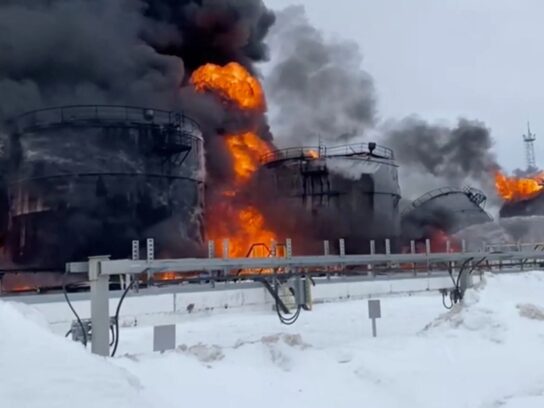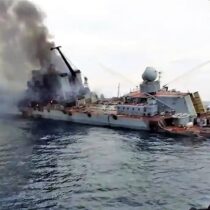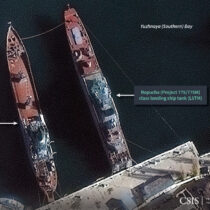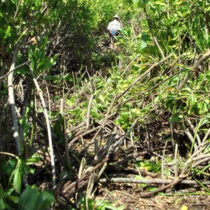
Who is winning the war in Ukraine? Everyone knows the answer, right? The Situation Report (SitRep) is that Ukraine is losing, correct?
Maybe.
Let’s figure it out. To do this, we need to be more careful about defining the word “war.” This is not just semantics. It is an important way of thinking. Almost every current analyst talks about the “war” as limited to the current conflict on the ground in Ukraine, and states that the war is a “stalemate,” a “deadlock,” or that Ukraine is slowly losing. I would argue that the “war” is much wider than that, and includes at the least the following eleven domains: geography; air; sea; cyber/comms; information; infrastructure/petro; economic; logistics/equipment; human mobilization; intelligence/leadership; and land.
Let’s tackle these one at a time, with half this month and half next, and perhaps we can guess when I will be able to visit my buddy in Kiev.
Geography
As in any war, geography and terrain are vital. Ukraine is slightly smaller than Texas, thus quite large, and consists mainly of rolling or flat plains at an elevation of about 575 feet. The rural plains are often cut up into fields bounded by tree lines, which are now used for cover by troops. The isolated Crimean peninsula is strategic for control of the Black Sea, and holding it is the main Russian objective. Secondary objectives are the Donetsk and Luhansk coal fields, oil fields, steel factories, chemical plants, and titanium, iron and lithium deposits. The Dnipro River divides the country north to south and is a major obstacle to invaders. Since Russian supply lines to Crimea could be cut off by destroying just three key bridges and interdicting seaborne supplies, the advantage here is to Ukraine.
The Air War
The Ukrainian Air Force is small, with only about 70 fighter/bombers vs. 800 for the Russians. But many Russian planes are not airworthy or are not deployed to Ukraine, and its losses in the war will reduce it by the summer of 2024 to about 75% of pre-war strength, according to the RAND Corporation. Rigid and rather timid Russian air doctrine and training are far inferior to Ukrainian, and Ukrainian Patriot missile traps are downing fighters and AWACS-type radar control planes. Neither side has yet achieved overall or even area air superiority, except in small areas such as Russian air dominance around Avdiivka and other foci. Promised but not yet delivered F-16s with long range radars will improve Ukraine’s position and may lead to air superiority bubbles over limited areas, facilitating ground attacks.
Ukrainians target military facilities in Ukrainian territory occupied by Russia and are now hitting more military nodes inside Russia, as they build and obtain longer range missiles and drones. Russians target civilian buildings, museums, hospitals, kindergartens and schools but also military targets. Both sides air defenses manage to stop perhaps 80-95% of attacks, but the Ukrainian efforts are more effective at degrading Russian military capabilities. This is changing, though, as Ukraine runs out of air defense missiles and ammunition.
After a year of requests, the US finally provided some ATACMS Block 1 ballistic missiles to Ukraine in October 2023 – but these only have a range of about 102 miles. The US refused to provide the 186-mile, Block 1a, Mach 3 ATACMS that everyone expected. These have still not been provided, after some more dithering in March 2024. If ever supplied, they could help make much of Crimea uninhabitable for the Russian military. But the always timid Biden Administration seems incapable of learning that it is the victim of what Russians call “reflexive control” – successful intimidation by saber-rattling.
Overall: advantage Russia, so far.
The War at Sea
Ukraine has no blue water navy left, only riverine craft, while the Russian Black Sea Fleet has about 57 vessels. Despite this, Ukrainian missile and sea drone attacks have destroyed the Fleet HQ, killed its Admiral and many senior officers, sunk its flagship and damaged or sunk about a third of the other vessels (including a submarine!), recaptured Snake Island and oil rigs south of Odesa, and chased the Fleet back to eastern Crimea and even to Russia. The Ukrainians have devised a way to export vital grain shipments to the Bosphorus and Danube and on to the world via sailing in Romanian territorial waters, thus avoiding Russian attacks. These accomplishments are astounding; hence: advantage “bigly” to Ukraine.
Cyberwar and Communications
Ukraine was damaged by Russian cyber attacks on its power grid in 2015 and by the NotPetya virus in 2017, which leaked out to the world and cost companies around the world billions of dollars. But after the 2022 invasion, Ukraine was able to hold off most major attacks, thanks to internal preparation and extensive technical assistance from US Cyber Command. The volunteer IT Army of Ukraine and Anonymous have both succeeded in attacking Russian websites, power grid, railway controls, broadcasters, streaming services, and the Russian media censorship agency.
In communications, Ukraine developed an excellent integrated battlefield management software package called Delta, in cooperation with NATO. Ukraine relies heavily on Elon Musk’s Starlink communications, with about 42,000 satellite terminals deployed by the military, hospitals, NGOs and businesses. However, Musk has apparently allowed third party vendors to evade sanctions and illegally sell Starlink terminals to Russia. Musk has reportedly also refused to cut off service to the Russian Starlink terminals in occupied Ukraine, which he could do, and has apparently dramatically reduced the bandwidth available to Ukrainian armed forces. Thus, he appears to be now acting as an agent of influence for Russia, while he previously favored Ukrainian and US interests.
Overall, a tie, for now.
Information War
Here Russia is clearly winning, having totally captured the US Republican Party and its constituents, the Hungarian leadership, many Slovakian politicians, and neutralized the global south. Russian intelligence double agent Alexander Smirnov hoodwinked the FBI for ten years by posing as a genuine informer, while actually feeding lies to the FBI, DoJ and the Republicans about Joe and Hunter Biden. Russian allies Donald Trump and Mike Johnson have stalled the key $60 billion Ukraine aid bill in the US House of Representatives, and are working hard to kill it permanently via delay, deflection, and introducing alternate no-hoper measures.
Russia intelligence has now been shown to be behind the numerous Polish trucker and farmer demonstrations against Ukrainian grain shipments, which also block deliveries of vital military supplies. And of course Russia has successfully intimidated current US, German and other Western leaders into dribbling in aid to Ukraine, instead of quckly delivering long range missiles, planes, high quality demining equipment, and other standard NATO-doctrine weapons.
Russian media outlets are even trying to blame the recent Tajik ISIS-K terrorist attack in Moscow on the Ukrainians, and have successfully deflected the world’s attention away from the fact that Moscow commits terrorist attacks against Ukraine every single day.
Experts estimate that 25% of the Russian population supports the war, 25% oppose, and 50% are just keeping their heads down. Almost the populace is intimidated and is unlikely to rise up, as did the famous “soldiers’ mothers” who successfully protested and helped stop Russia’s war in Afghanistan.
There were thousands of Russians in Russia and at overseas embassies who protested Putin’s re-election by showing up in long lines right at noon on the third day of voting, and often spoiling their ballots. Turnout was 77.5% (a record, but almost certainly substantially inflated), with 87.3% voting for Putin. A credible video in one location showed election workers literally and illegally stuffing ballot boxes for Putin after hours. Russian commanders in occupied Ukraine were directed to order their registered soldiers – dead or alive! – to vote for Putin. And residents of occupied Ukraine were visited by teams of armed soldiers, demanding that the residents vote “correctly” and early.
Overall: huge advantage to Russia.
Infrastructure and Petroleum War
In the winter of 2022-3 the Russians were able to substantially degrade Ukrainian energy and other utilities. These have now been defended and hardened. By contrast, Russia is sabotaging its own heating and water systems, with numerous winter failures across the country affecting millions of citizens. These were caused by disinvestment and losing local operating and maintenance engineers to military enlistment in the war in Ukraine.
Russia in essence is a huge gas station run by a Mafia gang. Petroleum and natural gas are its main sources of income. US sanctions have held down Russian petro-profits to some extent, and recent long range Ukrainian attacks on Russian oil refineries and depots promise to wipe out much of Russia’s capacity over the next six months, at least in the Black Sea and Baltic areas. The US feebly asked Ukraine to stop attacking refineries, since that might drive up world oil prices. But that was likely just a performative gesture.
Hence: overall advantage to Ukraine.
Economic War
NATO SecGen Jens Stoltenberg states that 18 of 31 NATO states will reach the NATO guideline of spending 2% or more of their GDP on defense this year, a six-fold increase from 2014. Poland is now spending close to 4%, while Russia is on a full wartime footing, spending about 10% of GDP, compared to 2% several years ago. The US is spending 3.5% of GDP on defense, but only about 5% of that 3.5% will help Ukraine, even if Congress passes the proposed but stalled $60 billion aid package. Ukraine is spending about 33% of its GDP on defense. All this is a major advantage to Russia, unless the US and Europe step up in this absolutely vital area.
Next month we will continue with our Situation Report on Ukraine.
Photos courtesy Lew Toulmin
- A. The Kremlin has recently issued a statement claiming that all lands that previously were under Russian control, at any time in history, are subject to Russian ownership. This includes Alaska, Mongolia, Finland and parts of China, Turkey and other countries, as shown in the map. Former Russian Prime Minister Medvedev also stated that war with the US is inevitable, because the US “will not return Alaska to Russia.”
- B. Alexei Navalny was murdered and martyred in February 2024 by Vladimir Putin. FSB officers visited his gulag prison a few days before he died of “sudden death syndrome.” Navalny’s body was withheld from his family, for “chemical analysis.”
- C. Chart of percent of GDP spent by the top spending NATO countries in 2023. Poland is at the top with 3.9%, followed by the US at 3.5%, while France is just below the 2.0% guideline at 1.9% and Germany is at 1.57% and Spain (both off the chart) is pathetic at 1.26%. Spain recently suffered the assassination on its soil by the Russian FSB secret service of a Russian helicopter pilot who defected to Ukraine with his helicopter loaded with jet plane parts and intelligence information.
- D. The huge Nevsky Mazut oil depot and refinery in St. Petersburg, Russia (Putin’s home town) on fire after being struck by a Ukrainian long range drone. Ukraine’s new tactic is to destroy Russia’s oil industry, now that world winter demand is winding down and oil prices are low – partly because the US is now pumping more oil per month than any country in world history. In recent months oil sales have accounted for up to 31% of the Russian government’s revenue – that will likely decline soon.
- E. Dense clouds of steam rise from broken water and heating pipes in Novosibirsk in southern Russia. A Kremlin report in 2022 stated that 31% of heating supply networks, more than 45% of sewage networks, and over 43% of water supply networks in Russia need to be replaced. Virtually none of this important work has been done.
- F. Two oil tankers smuggling sanctioned Russian oil. Russia’s “dark fleet” of about 500 old, tired, uninspected oil tankers regularly evade sanctions. One common method is to ship sanctioned Russian oil to a remote bay in southern Greece in a known Russian tanker, then pump the oil to another tanker alongside, under different ownership. The second tanker then sells the oil to China, India or other markets, claiming it is not sourced from Russia. But the payments make their way back to Russia via shell companies.
- G. How Elon Musk’s Starlink system works, with numerous small dishes on ground stations in Ukraine and elsewhere linked to hundreds of low earth orbit satellites. Musk has reportedly now allowed this vital system to be used by the Russians, thus violating sanctions.
- H. Evgenia Emerald, 33, call sign “Joan of Arc,” is the deadliest female sniper in the Ukrainian army. She won’t say how many Russians she has killed, but they call her “The Punisher.” About 25% of Ukrainian soldiers are female. The deadliest Ukrainian male sniper states that he has “far more” kills than the previous officially recognized world record sniper, Simo Hayha, a Finn who killed over 500 Russian soldiers in the 1939-40 Winter War.
- I. Sniper Evgenia Emerald at her wedding, held just behind the front lines. Her husband is Yevgeny Stipanyuk of the Armed Forces of Ukraine. Her bouquet is a traditional sheaf of wheat. They married on his birthday, and the bride said, “He will never forget the date of his wedding!”
















































Comments are closed.